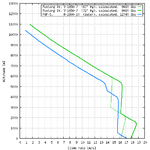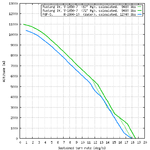FWIW, my vote is for the P-51 over the Hellcat. For the best of both types, it would be a P-51B/C versus the F6F-5.
The P-51 has the following advantages:
Level Speed
Diving Speed
Climb Rate
Roll Rate
They are equal in firepower for as long as it matters
The Hellcat has an edge in sustained turn.
I don't know which aircraft has better acceleration but with the climb rate advantage and power loading, the P-51 probably wins here as well. How can you win against someone who has every advantage except for low speed turns if he doesn't want to play your game? I don't think durability is enough.
- Ivan.
The P-51 has the following advantages:
Level Speed
Diving Speed
Climb Rate
Roll Rate
They are equal in firepower for as long as it matters
The Hellcat has an edge in sustained turn.
I don't know which aircraft has better acceleration but with the climb rate advantage and power loading, the P-51 probably wins here as well. How can you win against someone who has every advantage except for low speed turns if he doesn't want to play your game? I don't think durability is enough.
- Ivan.






